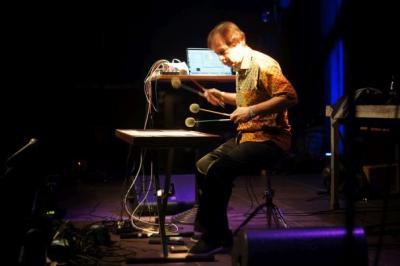Musik aus dem Globalen Süden und die Thematisierung von Queerness oder Postkolonialismus sind en vogue in der Festivallandschaft. Doch wie lässt sich kulturelle Aneignung oder «positive othering» verhindern? Ein Gespräch mit Thomas Gläßer, Initiator des Zentrums für Aktuelle Musik und Organisator des Digging the Global South Festivals in Köln über Musik als Ritual, Jutetasche tragendes Publikum und das Ungenügen an der Zivilisation.
Im Spätherbst 2017 fand das Festival Digging the Global South in Kooperation mit der Akademie der Künste der Welt in Köln und dem Europäischen Zentrum für Jazz und Aktuelle Musik im Stadtgarten in Köln, präsentiert von Norient, statt. Neben Avantgarde-Komponisten wie Lukas Ligeti waren auch zeitgenössische experimentelle Clubmusik-Künstlerinnen wie Faka oder Klein eingeladen. Einige der Gäste wie Moor Mother, Lukas Ligeti oder Don’t DJ hielten Vorträge und diskutierten mit dem Publikum, um über ihre Praxis oder ihre Einstellung zu Themen wie Exotismus oder kulturellem Imperialismus zu sprechen.
[Philipp Rhensius]: Die Geschichte der kulturellen Globalisierung ist eine der kognitiven Dissonanz: Menschen wollen starke Grenzen, die sie vom Rest der Welt abschotten, aber die Künste sollen möglichst kosmopolitisch, durchlässig, grenzenlos sein. Jene Widersprüche, die Sehnsucht nach neuer Musik aus nicht-europäischen Ländern einerseits und der Verschärfung von Grenzregimen und homogener kultureller Identität andererseits, ist ja die Ausgangsidee des Festivals. Was steckt dahinter?
[Thomas Gläßer]: Es ist auffällig, wie willkommen der globale Süden, Blackness, Queerness usw., also emanzipatorisch aufgeladenene Themen in Teilen der Kunstsphäre sind. Das ist erfrischend, erscheint mir aber auch wie ein eigenartiges und wenig wirksames Gegengift zu einer Selbstunsichtbarkeit westlicher Gesellschaften. Und natürlich werden diese Faktoren wie die Herkunft aus einem vermeintlich «realeren», «wilderen» Raum ausserhalb der Überflussgesellschaften dann auch Teil der Kommodifizierung der Künstler. Zugleich haben wir auch in nominell postkolonialen Zeiten mit massiven Machtasymmetrien und neokolonialen Ausbeutungsstrukturen zu tun, und mit einer Angst vor Einwanderung und kulturellem Identitätsverlust. Ich wollte ein Festival machen, dass das Begehren nach dem Anderen affirmiert und zugleich kritisch reflektiert - und damit auch den eigenen Standort in den Blick nimmt. Steckt in der Lust auf die Auseinandersetzung mit Kunst und Musik aus dem globalen Süden, aus Armuts- und Krisengebieten, auch ein Begehren nach gesellschaftlicher oder politischer Veränderung? Können wir in der selben Sphäre koexistieren und dabei Differenz - und vor allem auch Gemeinsamkeit - akzeptieren? Sind wir wirklich bereit, einander auf Augenhöhe zu begegnen? Können wir Projektionen zurücknehmen, uns selbst erlauben, das zu sein, was wir in Anderen sehen wollen und Anderen erlauben, das sein zu wollen, was wir in uns selbst sehen?
[PR]: Wenn wir nicht nur in der kulturellen Sphäre global und entgrenzt sein wollen, müsste es auch eine radikale Mobilität von Menschen geben.
[TG]: Wenn Kapital und Waren beweglich sind, warum nicht auch Menschen? Das ist übrigens auch ein Thema für Musiker aus Afrika, die bei vielen Reisezielen nicht selbstverständlich auf funktionstüchtige Visa-Regelungen zählen können. Bei manchen deutschen Botschaften kann es passieren, dass sie darauf bestehen, dass der deutsche Veranstalter die Haftung für Abschiebekosten übernimmt, für den Fall, dass der ein Musiker nicht wie geplant in sein Heimatland zurückkehrt.
[PR]: Wie kann ein Festival mit Schwerpunkt auf Musik solche sehr konkreten politischen Probleme angehen?
[TG]: Man kann solche Fragen im Dialog mit den Künstlern thematisieren, Diskurse befördern, Projektionen unterlaufen, symbolische Grenzen überschreiten. Wir neigen als Gesellschaft dazu, unser Ungenügen an der Zivilisation vor allem mit der kulturellen Sphäre zu kompensieren. Viele wichtige Fragen werden im Symbolischen und Ästhetischen kritisch und fantasievoll verhandelt, aber die Auswirkungen auf politische Strukturen sind gering.
[PR]: Wenn es jene Kompensation nicht gäbe, würde vielleicht direkte Politik gemacht werden?
[TG]: Politisch aufgeladene Kunst kann politische Aktionen bestimmt nicht ersetzen und ein Festival mit elektronischer Musik aus Afrika kann spannend und in vielerlei Hinsicht sinnvoll und wünschenswert sein, aber es stellt niemanden vor echte politische Herausforderungen.
[PR]: Weil sich alle so schön einig sind im Club oder auf dem Konzert...
[TG]: Weil es wenig kostet und viel Vergnügen bereitet, Musik zu hören, die einen herausfordert oder interessante Überschreitungen bedeutet. Ein alter Freund von mir arbeitet im produzierenden Gewerbe und er betont oft, dass er und seine Kollegen die Welt ganz anders erleben als die, die in kulturellen Bereichen, als Musiker, Kulturmanager oder Politiker arbeiten, die ständig mit den darin verhandelten Ideen konfrontiert sind und auch die Zeit und Energie haben, sich auf dieser Ebene mit der Welt auseinanderzusetzen. Das ist ein anderer Empfindungshorizont.
[PR]: Inwiefern tragen Festivals wie Digging The Global South, das ja auch feste Identitäten wie nationale Zugehörigkeiten kritisch betrachtet, dennoch zur «Topophilie» bei, also der Lust, jede Musik immer zugleich auch geographisch zu verorten?
[TG]: Die digitale Sphäre scheint den Raum unendlich zu machen, während zugleich, vielleicht sogar als Reaktion darauf, die geografische Herkunft noch stärker als zuvor zu einem Teil der Aufwertung von Waren wird. Wie sich diese Spannung unter den Bedingungen der Digitalisierung verändert, hat mich auch bei Digging the Global South interessiert.
[PR]: Warum war es dennoch so wichtig, die Differenz über die Herkunft zu markieren?
[TG]: Um die Realität von Diaspora und Migration mit abzubilden. Ich glaube, dass Musik oft auch von ihrem Herkunftsort und sozialen Kontext geprägt ist. Die Popmusikgeschichte zeigt, dass bestimmte Stile oft an Orten entstehen, an denen sich Vorstellungen von Musik und Sound verdichten. Mit DJ Marfox aus der Batida-Szene von Lissabon und DJ Lag aus der Gqom-Szene von Durban hatten wir zwei Produzenten im Programm, deren Sound eindeutig interessante lokale Kontexte mitbringt.
[PR]: Ist es denn nicht bedenklich, die Herkunft so stark zu betonen? Die deutsche Rapperin Ace Tee etwa, wurde im «Diaspora-Special» des The Fader-Magazins immer wieder als Frau mit ghanaischen Wurzeln erwähnt, obwohl sie in Berlin geboren und in Hamburg aufgewachsen ist.
[TG]: Es kann schnell zur Romantisierung führen, weil auf das Fremde viel projiziert wird. Das findet ja auch im Musikjournalismus statt. Aktuell etwa bei Texten über Gqom, wenn etwa die Gewalt und Armut in den Townships von Durban betont werden. Das sehe ich kritisch, weil es eine Projektionsmaschine in Gang setzt. Da entsteht schnell sowas wie ein romantisches «positive othering». Aber genau daher sind Kontexte und Zuordnungen wichtig. Dann lassen sich solche Projektionen differenzierter befragen. Dafür sind Orte und reale Begegnungen sehr wichtig. Mich interessiert, eine Form von Öffentlichkeit herzustellen, in der unselbstverständliche Verständigungen stattfinden.
[PR]: Welche Öffentlichkeit?
[TG]: Ich meine eine Öffentlichkeit, die aus gemeinsamen Erlebnissen und dem persönlichen Austausch über die Grenzen der eigenen «Filterblase» hinaus besteht. Der Stadtgarten ist ein subventioniertes Haus und damit geht einher, an die Öffentlichkeit zu denken. Das Publikum erhofft sich, Zugang zu etwas Neuem zu bekommen und dass eine Auseinandersetzung stattfinden kann. Die Heterogenität von Programmen erscheint mir immer noch ein Weg zu sein, ein diverses Publikum zu erreichen, wie bei Digging the Global South in der Mischung von Konzerten, Vorträgen, Diskussionen, Filmen und sehr unterschiedlichen musikalischen Registern.
[PR]: Ist es nicht oft auch so, dass eine echte Auseinandersetzung mit der Musik und ihrem Kontext viel Energie fordert, die Viele nicht mehr aufbringen möchten, die nach erledigter Lohnarbeit vor allem unterhalten werden möchten?
[TG]: Teilweise stimmt das, aber gleichzeitig erlebe ich immer wieder ein grosses Interesse an Hintergründen, Lectures oder Gesprächen, auch im musikalischen Zusammenhang. Als eine Art magisches Ritual erzeugt Musik oft eine kollektive Resonanz, aber durch die Auseinandersetzung mit der Musik selbst oder durch ihre Einbettung in soziale Formationen mit und Ritualen, in klassischen Subkulturen zum Beispiel, eröffnen sich oft andere Sinnzusammenhänge und auch eine gewisse Tiefe, die mir wertvoll erscheint und die ein Soundfile nicht transportieren kann.
[PR]: Manchmal geht die Tiefe einfach mit dem falschen Kontext verloren. Du hattest vorhin mal die Wiener Festwochen erwähnt, wo es 2017 einen Fokus auf Performance, Queerness und Blackness gab.
[TG]: Das habe ich bei allen guten Absichten der Kuratoren im Grunde als eine Art modische Appropriation erlebt. Ich hatte beim Hyperreality-Clubmusik-Event das Gefühl, dass sich Clubs als soziales Sphäre und Clubmusik nicht einfach so in ein hochkulturelles, hoch subventioniertes Festival verpflanzen lassen. Es ist eigenartig, wenn Lotic und Juliana Huxtable in einem Saal spielen, wo vermutlich nächste Woche wieder Hochzeiten gefeiert werden, nur um den Ort mit einer transgressiven Realität einzufärben. Und dann kommen Jutetasche tragende Studenten hin und versuchen, das hip zu finden. Ich finde, das hat nicht funktioniert und mich auch vieles an der Planung für Digging the Global South nochmal in Frage stellen lassen.
[PR]: Ein Gegensatz zwischen Anspruch und Wirklichkeit?
[TG]: Ja, als ich das Programm las, war ich begeistert. Aber vor Ort habe ich mich gefragt, was hier eigentlich passiert. Ist das jetzt eine nennenswerter kultureller Inklusion oder eine verfehlte Musealisierung einer lebendigen Subkultur, die eigentlich keinen kulturellen Mehrwert bringt?
[PR]: Der italienische Philosoph Antonio Gramsci war überzeugt, dass politischer Kampf auch der Kampf um die Hegemonien an Ideen ist und dass diese vor allem auch in kulturellen Bereichen entwickelt werden.
[TG]: Das Stichwort hier ist Gedankenwelt. Eine, die eine Rückkopplung hat, die lebensrelevant wird. Sodass es einen Zusammenhang gibt zwischen dem, was du lebst und was du denkst. Ich habe nicht oft das Gefühl, dass diese Rückkopplung wirksam zustande kommt.
[PR]: Wie könnte diese Rückkopplung dann geschaffen werden? Wie kann Musik diese Situationen herstellen?
[TG]: Musik erzeugt immer Resonanzen und ist in der Lage, bestimmte Bewusstseinszustände und -haltungen zu akzentuieren. Beim Hören entsteht eine Nähebeziehung und damit auch eine Art, die Welt auf eine bestimmte Weise erleben zu können. Rituelle Musiken machen sich das zum Beispiel zunutze, indem sie auf das kollektive Erlebnis setzen und es mit symbolischen Ordnungen verknüpfen. Andererseits sollen solche Veranstaltungen die sinnlich-emotionale Erfahrung um eine diskursive Ebene erweitern, die interessante Zugänge und ein tieferes Verständnis eröffnen kann.






